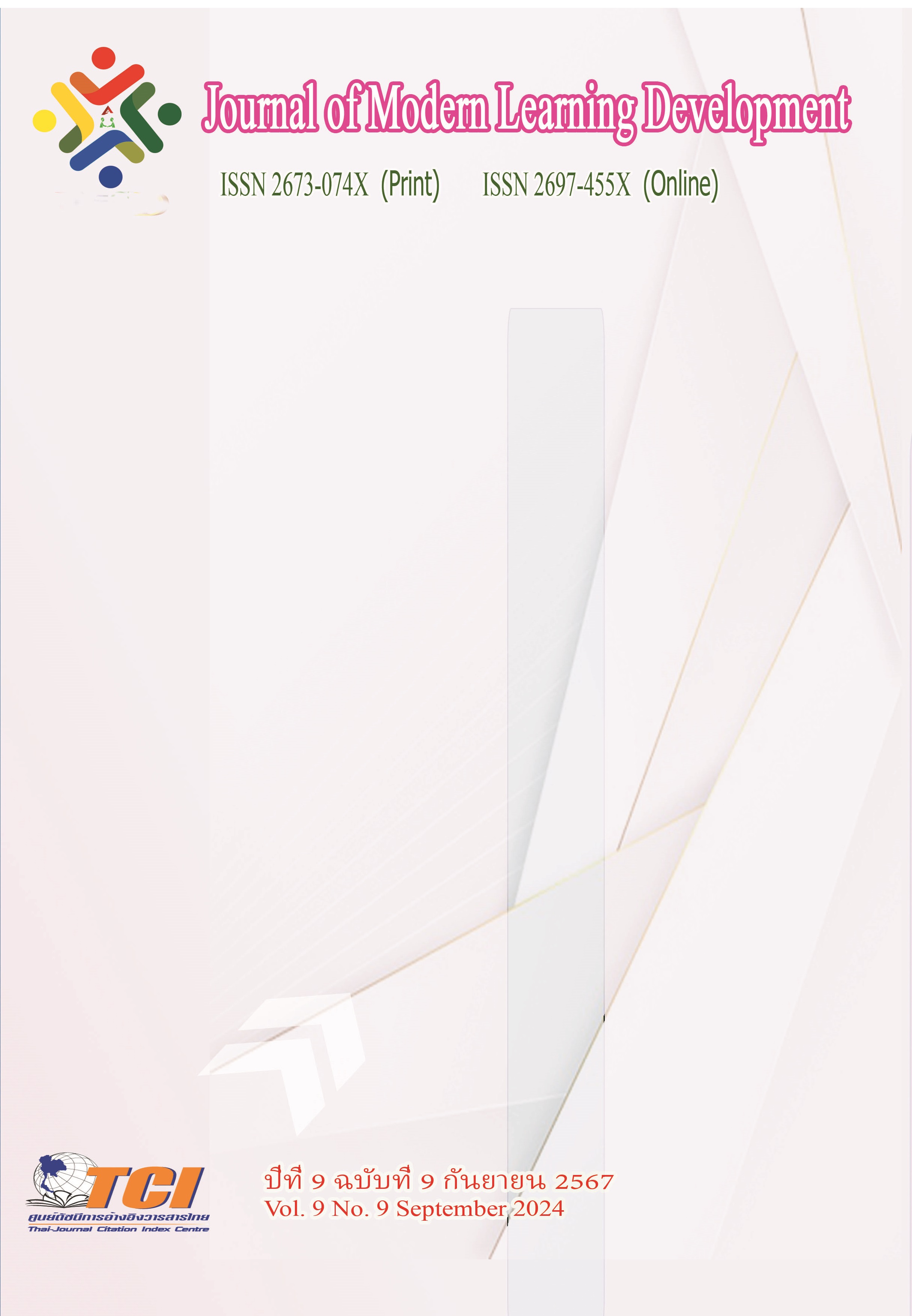Guidelines for Managing Agricultural waste Project
Main Article Content
Abstract
This article aims to propose guidelines for managing agricultural waste. Currently, Thailand has economic crop plantations throughout the country. Most farmers' primary goal is to increase production by accelerating the growth of economic crops, allowing for multiple harvests within a single year. They often achieve this through poor management practices, such as burning agricultural waste, which is a simple, convenient, quick, and low-cost solution. Specifically, the open burning of sugarcane leaves, rice stubble, straw, and maize stubble as animal feed has emerged as a major contributor to haze and PM2.5 particulate pollution. This article provides management principles for effectively utilizing agricultural waste after harvesting. The goal of this suggestion is to assist farmers in minimizing production expenses and enhancing the value of agricultural waste. Additionally, it promotes the development of natural resources and environmental rotation, generating options for transforming agricultural waste into products that enhance their value and are appropriate for each region in Thailand. Furthermore, it facilitates the effective use of agricultural waste as a key resource across various industries and bioenergy sectors.
Successfully enhancing the value of agricultural waste requires collaboration across diverse sectors, including government agencies, local administrative organizations, the private sector, and the targeted group of farmers. The operation methods should be tailored to the unique context, challenges, and needs of farmers in each region, providing them with viable and sustainable options to boost their household income.
Article Details
References
กระทรวงยุติธรรม. (2565). กฎหมายน่ารู้ ตอนที่ 38 การเผาหญ้า เผาขยะ มีความผิดทั้งจำ ทั้งปรับ. ออนไลน์. สืบค้น 8 กรกฎาคม 2567. แหล่งที่มา: https://www.moj.go.th/view/70151
กรุงเทพธุรกิจ. (2567). ถอดบทเรียน เศรษฐกิจหมุนเวียน สู่การเกษตรยั่งยืน. ออนไลน์. สืบค้น 4 สิงหาคม 2567. แหล่งที่มา: https://www.bangkokbiznews.com/social/906655
กองสาธารณสุขและสิ่งแวดล้อม เทศบาลตำบลชะมาย อำเภอทุ่งสง จังหวัดนครศรีธรรมราช. (2563). เอกสารเผยแพร่ประชาสัมพันธ์. ออนไลน์. สืบค้น 9 มิถุนายน 2567. แหล่งที่มา: https://www.chamai. go.th/fileupload/8441104353.pdf
ชัชวาล จันทรวิจิตร. (2565). ควันจากการเผาชีวมวลอาจอันตรายกว่าที่คิด. วารสารสิ่งแวดล้อม มหาวิทยาลัยนเรศวร. 26 (2), 1-7.
ชัยสิทธิ์ ทองจู. (2563). การใช้ประโยชน์จากวัสดุเหลือใช้ทางการเกษตรและอุตสาหกรรมเพื่อประโยชน์ทางการเกษตร. วารสารเกษตรอภิรมย์ มหาวิทยาลัยเกษตรศาสตร์, 6 (30), 44-45.
ผู้จัดการออนไลน์. (2565). วว.เพิ่มมูลค่าวัสดุเหลือทิ้งทางการเกษตร พัฒนาเป็นกระถางเพาะชำย่อยสลายได้. ออนไลน์. สืบค้น 11 มิถุนายน 2567. แหล่งที่มา: https://mgronline.com/science/detail/ 9650000027788
วิลาวรรณ น้อยภา และ วาสิฐี ภักดีลุน. (2564). การจัดการและลดการเผาในพื้นที่เกษตรของประเทศไทย. ออนไลน์. สืบค้น 24 มิถุนายน 2567. แหล่งที่มา: https://www.tei.or.th/file/files/ Agricultural%20Burning%20Management%20in%20Thailand_TEI-th.pdf
วีรชัย อาจหาญ และคณะ. (2555). โครงการศึกษาแนวทางการบริหารจัดการวัสดุเหลือใช้ทางการเกษตรเพื่อใช้เป็นเชื้อเพลิงและลดการเกิดหมอกควัน. รายงานการวิจัย. สำนักงานคณะกรรมการวิจัยแห่งชาติ.
สถานีพัฒนาที่ดินเชียงใหม่ สำนักงานพัฒนาที่ดินเขต 6. (2566). โครงการสร้างมูลค่าเพิ่มจากวัสดุเหลือใช้ทางการเกษตร. ออนไลน์. สืบค้น 4 มิถุนายน 2567. แหล่งที่มา: http://www.chiangmailand.go.th/ data/photo/cmi2567/jan/08-08-2566/photo_oct_08.html
สถาบันวิจัยและพัฒนาแห่งมหาวิทยาลัยเกษตรศาสตร์. (2564). บล็อกกันความร้อนลายหินอ่อนจากวัสดุเหลือใช้ทางการเกษตร. ออนไลน์. สืบค้น 11 มิถุนายน 2567. แหล่งที่มา: https://www3.rdi.ku.ac. th/?p=68017
สามารถ ใจเตี้ย. (2564). การใช้ประโยชน์วัสดุเหลือใช้ทางการเกษตรของเกษตรกรเทศบาลตำบลขี้เหล็ก อำเภอแม่ริม จังหวัดเชียงใหม่. วารสารวิจัยและส่งเสริมวิชาการเกษตร มหาวิทยาลัยแม่โจ้. 38 (2), 79-88.
สุมาลี เม่นสิน และ วัลภา อูทอง. (2565). โครงการวิจัยผลิตภัณฑ์จากวัสดุเหลือใช้ทางการเกษตรทำสำคัญบนพื้นที่สูงเพื่อการปรับปรุงดินและเพิ่มการกักเก็บคาร์บอนในดิน. สถาบันวิจัยและพัฒนาพื้นที่สูง (องค์การมหาชน). ออนไลน์. สืบค้น 4 มิถุนายน 2567. แหล่งที่มา: https://research.hrdi.or.th/ research/detail/591/
สำนักงานพัฒนาวิทยาศาสตร์และเทคโนโลยีแห่งชาติ (สวทช.). (2563). โมเดลเศรษฐกิจใหม่ BCG. ออนไลน์.
สืบค้น 20 กรกฎาคม 2567. แหล่งที่มา: https://www.nstda.or.th/home/knowledge_post/bcg-
by-nstda/
สำนักงานเศรษฐกิจการเกษตร. (2567). โครงการสร้างมูลค่าเพิ่มจากวัสดุเหลือใช้ทางการเกษตร ปี 2567
ลดปริมาณวัสดุเหลือใช้ สู่การสร้างรายได้ สร้างสมดุลระบบนิเวศในชุมชน. ออนไลน์. สืบค้น
มิถุนายน 2567. แหล่งที่มา: https://www.oae.go.th/view/1/รายละเอียดข่าว/ข่าว%20สศก./45208/TH-TH


